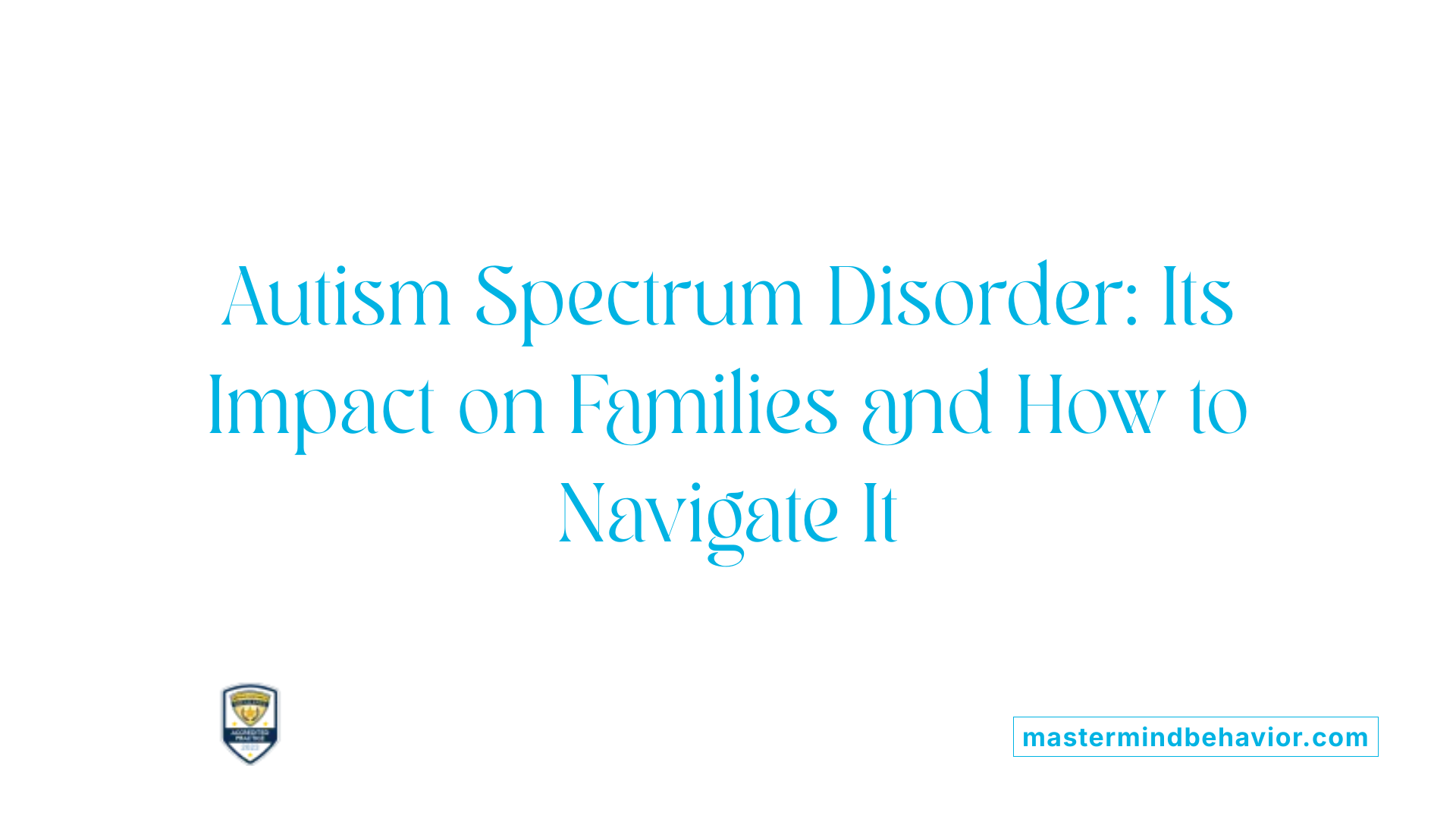Understanding the Caregiver’s Challenge
Families caring for children with autism face intense and ongoing challenges that can lead to significant stress and burnout. This article explores how Applied Behavior Analysis (ABA) therapy assists not only individuals with autism but also offers tools and support to help caregivers manage the emotional and physical demands of their role effectively.
What is Autism Spectrum Disorder and How Does It Impact Families?

Defining Autism Spectrum Disorder (ASD) and Its Behaviors
Autism Spectrum Disorder (ASD) is a neurodevelopmental condition marked by difficulties in social communication, interaction, and the presence of restricted or repetitive behaviors. Individuals with ASD often show behaviors like hand-flapping, rocking, or repetitive motions, which may serve as self-soothing or ways to manage anxiety. Sensory sensitivities are common; some people with ASD are over-responsive or under-responsive to environmental stimuli such as sounds, lights, or textures. These differences can make typical social cues challenging to understand, and behaviors may vary widely from person to person.
How ASD Affects Communication and Sensory Processing
Communication challenges in ASD include difficulties in understanding spoken language, maintaining eye contact, or engaging in reciprocal social interaction. Some individuals may be nonverbal or use alternative methods like Picture Exchange Communication Systems (PECS). Sensory sensitivities can trigger meltdowns or withdrawal when an individual is exposed to overwhelming or unpredictable sensory input. These characteristics contribute to complex behavioral patterns that require individualized support.
Impact on Caregiver Responsibilities
Families caring for a person with ASD face numerous demands. Caregivers often manage behavioral challenges like aggression, repetitive behaviors, and difficulties with transitions, which stem from frustration, sensory overload, or changes in routine. Coordinating therapies, advocating for services, and adapting daily routines demand significant time and emotional resources.
The constant unpredictability and intensity of these responsibilities can lead to physical and emotional exhaustion known as caregiver burnout. Understanding ASD's effects helps in recognizing the importance of support, education, and coping strategies for families navigating these challenges.
The Nature and Impact of Caregiver Stress in Autism

What Are Common Symptoms and Causes of Caregiver Burnout?
Caregiver burnout is a frequent challenge for families supporting individuals with autism. It often manifests as feelings of being overwhelmed, emotional exhaustion, physical fatigue, sadness, guilt, and difficulty engaging socially. These symptoms reflect the intense demands caregivers face daily.
How Does Caregiving Lead to Exhaustion?
Caring for a person with autism involves not only physical effort but also emotional and mental strain. The unpredictability and prolonged nature of caregiving responsibilities contribute to chronic stress. Caregivers may experience physical exhaustion alongside psychological effects, such as feeling emotionally drained, from managing their loved one's complex needs.
What Are the Main Stressors in Autism Caregiving?
Several factors increase stress among caregivers. Managing behavioral challenges such as aggression or repetitive behaviors requires constant attention and intervention. Coordinating various therapies, including ABA therapy, and advocating for services adds administrative stress. The need to balance these tasks with family and personal life often overwhelms caregivers.
Understanding these elements highlights the significant toll caregiving can take, emphasizing the importance of support and strategies to manage stress effectively.
An Introduction to Applied Behavior Analysis (ABA) Therapy
What is Applied Behavior Analysis (ABA) therapy?
Applied Behavior Analysis, or ABA, is a science-based therapy focusing on understanding how behavior works and using that knowledge to encourage positive behaviors and reduce challenges. This approach teaches skills step-by-step using techniques like positive reinforcement, where desired actions are rewarded to promote repetition.
ABA therapy is personalized to fit each individual's unique needs, especially benefiting children with autism by improving communication, social skills, and daily living activities. The therapy relies on systematic data collection and adapts over time based on each person's progress.
How is ABA individualized and evidence-based?
ABA uses a customized treatment plan designed after thorough assessments of behavior and environment. The therapy breaks down complex skills into manageable steps to help learners master each part effectively.
It combines structured techniques, like Discrete Trial Training, with natural settings approaches to make learning meaningful and generalizable. These methods are backed by extensive research demonstrating their effectiveness in supporting individuals with autism.
Furthermore, ABA continuously measures results to refine strategies, ensuring interventions remain beneficial and minimize stress.
Who provides ABA therapy and their qualifications?
ABA services are delivered by trained professionals known as Board Certified Behavior Analysts (BCBAs), as well as behavior technicians and therapists who specialize in autism interventions.
Becoming an ABA therapist generally requires higher education in relevant fields, supervised training, and certification through standardized exams. The most recognized credentials include BCBA and Board Certified Assistant Behavior Analyst (BCaBA).
These experts often collaborate with families and other care providers in healthcare and educational environments to create and implement effective, individualized treatment plans.
Their advanced training ensures they can competently apply evidence-based ABA strategies to support behavioral and developmental needs.
The Typical ABA Therapy Process: From Assessment to Intervention
What is the typical process of ABA therapy from assessment to intervention?
The ABA therapy process starts with an initial comprehensive assessment conducted by a Board Certified Behavior Analyst (BCBA). This assessment identifies the individual's unique strengths and areas requiring support, covering communication, social skills, behavior challenges, and sensory sensitivities.
Following assessment, the BCBA develops a personalized treatment plan. This plan sets clear, measurable goals tailored to the individual's needs, such as improving communication, reducing challenging behaviors, and enhancing social interactions. Goal setting ensures that progress is specific and trackable.
Intervention delivery involves applying evidence-based techniques customized to the person's environment and developmental level. Techniques include positive reinforcement to encourage desirable behaviors, discrete trial training for skill-building, and naturalistic teaching strategies that integrate learning into day-to-day activities.
Throughout therapy, ongoing data collection is crucial. Therapists meticulously track behavior and skill acquisition, allowing continuous monitoring of progress. This data-driven approach supports timely adjustments to treatment plans, ensuring effectiveness and responsiveness to changing needs.
The ultimate aim is skill acquisition, behavior reduction, and promoting generalization—applying learned skills across various settings in daily life. Consistent family involvement and collaboration with therapists maximize the benefits and support during all stages of ABA therapy, improving overall quality of life for individuals with autism.
How ABA Therapy Supports Children and Eases Caregiver Stress
ABA Techniques for Behavior Management and Skill Building
Applied Behavior Analysis (ABA) therapy uses a structured approach to help children with autism develop crucial social, communicative, and behavioral skills. Therapists create personalized treatment plans that break down complex skills into manageable steps. Techniques such as positive reinforcement encourage desired behaviors, while strategies like visual schedules and token economies reduce challenging behaviors. ABA also incorporates relaxation exercises and sensory tools like deep breathing and fidget toys to address anxiety and sensory sensitivities.
Role of ABA in Reducing Caregiver Burden
ABA therapy significantly eases caregiver stress by directly addressing the behavioral challenges that often cause frustration and exhaustion. By improving the child's communication and social skills, ABA reduces problematic behaviors like aggression and repetitive actions. This support helps create a more predictable and manageable home environment, lowering caregivers’ physical and emotional strain. Families also benefit from the data-driven nature of ABA, allowing adjustments to interventions that better meet each child's evolving needs.
Teaching Practical Strategies to Parents
A critical component of ABA therapy is equipping parents and caregivers with practical tools to support their children daily. ABA professionals train families to implement behavior management techniques consistently across settings. This includes using structured routines, visual aids, and positive reinforcement at home. Additionally, caregivers learn to recognize and address triggers for challenging behaviors, improving their confidence and reducing feelings of burnout. Overall, the collaborative approach empowers families, fostering a supportive environment that promotes long-term progress and well-being.
Managing Common Behavioral Challenges through ABA and Caregiver Support

Typical Behavioral Issues in Autism and Their Triggers
Individuals with autism often face challenges including repetitive behaviors, aggression, sensory sensitivities, and difficulty with transitions. These behaviors stem from various causes: repetitive actions may serve as self-soothing mechanisms, while aggression can be triggered by frustration, communication difficulties, sensory overload, or unexpected changes. Sensory sensitivities might cause meltdowns or withdrawal due to over- or under-responsiveness to stimuli. Unmet needs or environmental factors frequently underlie behavioral incidents, so careful tracking helps identify specific triggers.
ABA Strategies to Address Behaviors Such as Aggression and Sensory Sensitivities
Applied Behavior Analysis (ABA) provides effective, personalized approaches to manage these challenges. ABA therapists use positive reinforcement to reduce problematic behaviors and teach new skills, such as functional communication and social skills training. Behavioral interventions may include token economies and the use of visual schedules to encourage desired behaviors. Relaxation techniques like deep breathing, progressive muscle relaxation, and sensory tools (e.g., fidget toys, noise-canceling headphones) help children manage anxiety and sensory overload. Throughout therapy sessions, emphasis is placed on coping skills and emotional regulation to foster well-being and reduce stress.
Importance of Structured Routines and Visual Schedules
Creating structured home environments with predictable routines and clear instructions greatly benefits individuals with autism. Visual schedules aid in setting expectations and smoothing transitions, which can decrease anxiety and disruptive behaviors. Sensory integration techniques, like deep pressure and scheduled sensory breaks, further support emotional regulation. Family and caregiver involvement in implementing these routines ensures consistency across settings, enhancing the effectiveness of interventions and supporting the child’s development.
| Behavioral Challenge | Common Triggers | ABA-Based Support Techniques |
|---|---|---|
| Repetitive Behaviors | Anxiety, self-soothing | Functional communication training, teaching alternative skills |
| Aggression | Frustration, communication difficulty, sensory overload | Positive reinforcement, token economies, relaxation methods |
| Sensory Sensitivities | Environmental stimuli overload or under-responsiveness | Sensory integration approaches, sensory-friendly tools |
| Transition Difficulties | Changes in routine or environment | Visual schedules, structured routines, social skills training |
Together, ABA interventions and caregiver support create a comprehensive framework that helps manage behavioral challenges effectively while promoting emotional health and reducing caregiver burnout.
Practical Stress Management Strategies for Caregivers During ABA Therapy
Prioritizing Caregiver Health and Respite Options
Caregivers of children with autism face high stress levels from managing behavioral challenges and therapies. To combat burnout, it's essential for caregivers to prioritize their own physical and emotional health. Utilizing respite care services provides crucial breaks, allowing caregivers time to rest and recharge. Maintaining a healthy lifestyle with regular exercise, sleep, and nutrition also supports resilience during demanding caregiving periods.
Use of Support Groups and Professional Counseling
Finding support groups where caregivers can share experiences and strategies helps reduce feelings of isolation and overwhelm. These communities offer emotional encouragement and practical advice. Additionally, seeking professional counseling enables caregivers to address stress and emotional drain proactively, fostering mental well-being while navigating the challenges of caregiving.
Stress Management Techniques Integrated Within ABA Therapy
ABA therapy not only benefits the child but also supports caregivers by incorporating stress-reduction methods. Therapists teach practical tools, such as visual schedules and structured routines, which reduce unpredictability and behavioral triggers at home. Relaxation techniques like deep breathing, mindfulness, and sensory tools (e.g., fidget toys or noise-canceling headphones) are integrated into therapy sessions. These approaches help manage anxiety and improve coping skills for both children and caregivers.
By combining personal self-care with supportive resources and ABA-based strategies, caregivers can better manage stress, reduce burnout, and create a more positive caregiving environment.
The Role of Family and Professional Collaboration in Successful ABA Outcomes
Why Is Consistent Strategy Implementation Across Environments Important?
Consistency is essential for effective ABA therapy outcomes. When families and professionals implement strategies uniformly at home, school, and other settings, the child experiences a predictable and structured environment. This consistency encourages skill generalization, reduces anxiety, and enhances behavioral improvements. Without aligning approaches, children may face confusion, which can hinder progress and increase stress.
How Does Training and Support Benefit Caregivers?
Caregivers play a crucial role in the success of ABA interventions. Training programs equip them with practical techniques to manage challenging behaviors and reinforce positive skills. Support groups provide emotional relief and shared experiences, reducing feelings of isolation and burnout. Collaborations with professionals offer ongoing guidance, ensuring caregivers can adapt strategies effectively and feel confident in their role.
What Ethical Standards Ensure the Child's Well-Being in ABA?
Modern ABA therapy strictly adheres to ethical principles that prioritize the child’s emotional and physical health. The focus is on building skills, promoting emotional regulation, and using positive reinforcement to reduce stress. Therapists tailor interventions to the child’s unique needs, emphasizing respect, dignity, and minimizing discomfort. This ethical approach ensures that therapy supports holistic well-being rather than just behavioral compliance.
Collaborative efforts between families and professionals grounded in consistent strategies, caregiver support, and ethical practice create an environment where children with autism can thrive. These partnerships not only promote effective skill acquisition but also foster emotional security crucial for children’s development.
Early Intervention and Long-Term Benefits of ABA Therapy for Families

How does early ABA intervention impact developmental outcomes?
Early intervention using Applied Behavior Analysis (ABA) significantly enhances developmental milestones in children with autism. ABA therapy focuses on personalized treatment plans that break down complex skills into manageable steps, making learning more accessible. This method reinforces positive behaviors and communication skills from a young age, leading to improved social interactions, better communication abilities, and reduced behavioral challenges.
How does early support reduce the severity of future challenges?
By addressing behavioral, sensory, and communication issues early on, ABA therapy helps minimize the severity of future difficulties. The structured routines and visual schedules introduced through ABA create predictability, which lowers anxiety and reduces disruptive behaviors. Early intervention also equips children with coping strategies that support emotional regulation, lessening the impact of stress triggers as they grow.
What are the long-term improvements in caregiver coping and child independence?
Families benefit greatly over time when they engage in early ABA therapy. Caregivers learn practical tools to manage challenging behaviors effectively, which alleviates stress and burnout. Furthermore, as children develop increased independence through targeted skill-building, caregivers experience a reduced demand for intensive support. This progress improves overall family quality of life, allowing for more balanced social and emotional engagement within the household.
In summary, early ABA intervention not only fosters developmental gains in children with autism but also plays a crucial role in reducing future challenges and enhancing the well-being of caregivers through sustained support and empowerment.
Empowering Caregivers Through Knowledge and Support
Caring for a child with autism is an enduring journey filled with unique challenges that can strain even the strongest caregivers. ABA therapy stands as a beacon, not only fostering meaningful progress in children but also equipping families with strategies to manage stress effectively. By understanding autism’s complexities, embracing evidence-based interventions, prioritizing caregiver well-being, and fostering collaboration among professionals and families, the path forward becomes less daunting. Empowered caregivers serve as vital advocates and supporters, making a profound difference in the lives of their loved ones and themselves.
References
- Managing Caregiver Burnout: The Impact Of Autism On ...
- How to Manage Behavioral Challenges in Autism
- Exploring ABA Therapy for Autism-Related Stress
- How to Become an Applied Behavior Analyst (ABA) Therapist
- How to Become an ABA Therapist - School of Education
- Applied Behavior Analysis (ABA)
- Applied Behavior Analysis (ABA)









